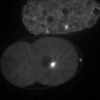Free Online Productivity Tools
i2Speak
i2Symbol
i2OCR
iTex2Img
iWeb2Print
iWeb2Shot
i2Type
iPdf2Split
iPdf2Merge
i2Bopomofo
i2Arabic
i2Style
i2Image
i2PDF
iLatex2Rtf
Sci2ools
ISBI
2008
IEEE
2008
IEEE
Multiframe sure-let denoising of timelapse fluorescence microscopy images
Due to the random nature of photon emission and the various internal noise sources of the detectors, real timelapse fluorescence microscopy images are usually modeled as the sum of a Poisson process plus some Gaussian white noise. In this paper, we propose an adaptation of our SURE-LET denoising strategy to take advantage of the potentially strong similarities between adjacent frames of the observed image sequence. To stabilize the noise variance, we first apply the generalized Anscombe transform using suitable parameters automatically estimated from the observed data. With the proposed algorithm, we show that, in a reasonable computation time, real fluorescence timelapse microscopy images can be denoised with higher quality than conventional algorithms.
Gaussian White Noise | ISBI 2008 | Medical Imaging | Real Fluorescence Timelapse | Real Timelapse Fluorescence |
| Added | 20 Nov 2009 |
| Updated | 20 Nov 2009 |
| Type | Conference |
| Year | 2008 |
| Where | ISBI |
| Authors | Saskia Delpretti, Florian Luisier, Sathish Ramani, Thierry Blu, Michael Unser |
Comments (0)

